System Modelling Report: Amazon FBA System Design and Analysis
VerifiedAdded on 2020/12/30
|11
|1616
|344
Report
AI Summary
This report provides a comprehensive system modelling analysis of Amazon's Fulfillment by Amazon (FBA) system. It begins with an introduction to system modelling, emphasizing its role in IT system construction and data flow within businesses. The report identifies and describes the roles of four key stakeholders: customers, employees, owners, and suppliers, highlighting their involvement in the system's operations. It then details various use cases for each stakeholder, including account creation, browsing the catalog, purchasing products, and providing feedback for customers; viewing customer data and managing stock for employees; bidding for and supplying products for suppliers; and adding and deleting products for owners. Use case diagrams and class diagrams are also presented to visually represent the system's structure and interactions. The report concludes by summarizing the importance of system modelling in IT system design and the differentiated roles of stakeholders in the Amazon FBA environment.
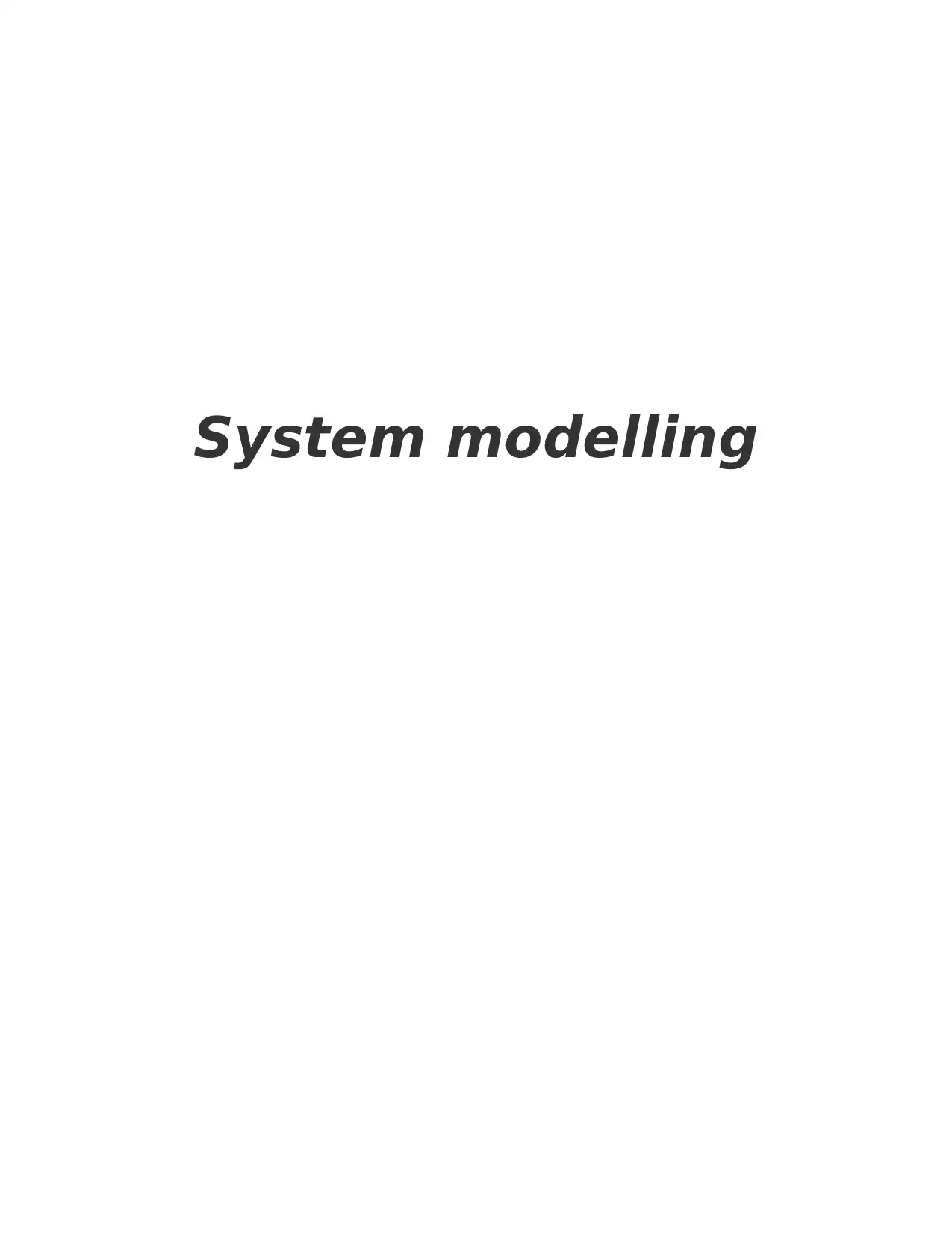
System modelling
Paraphrase This Document
Need a fresh take? Get an instant paraphrase of this document with our AI Paraphraser
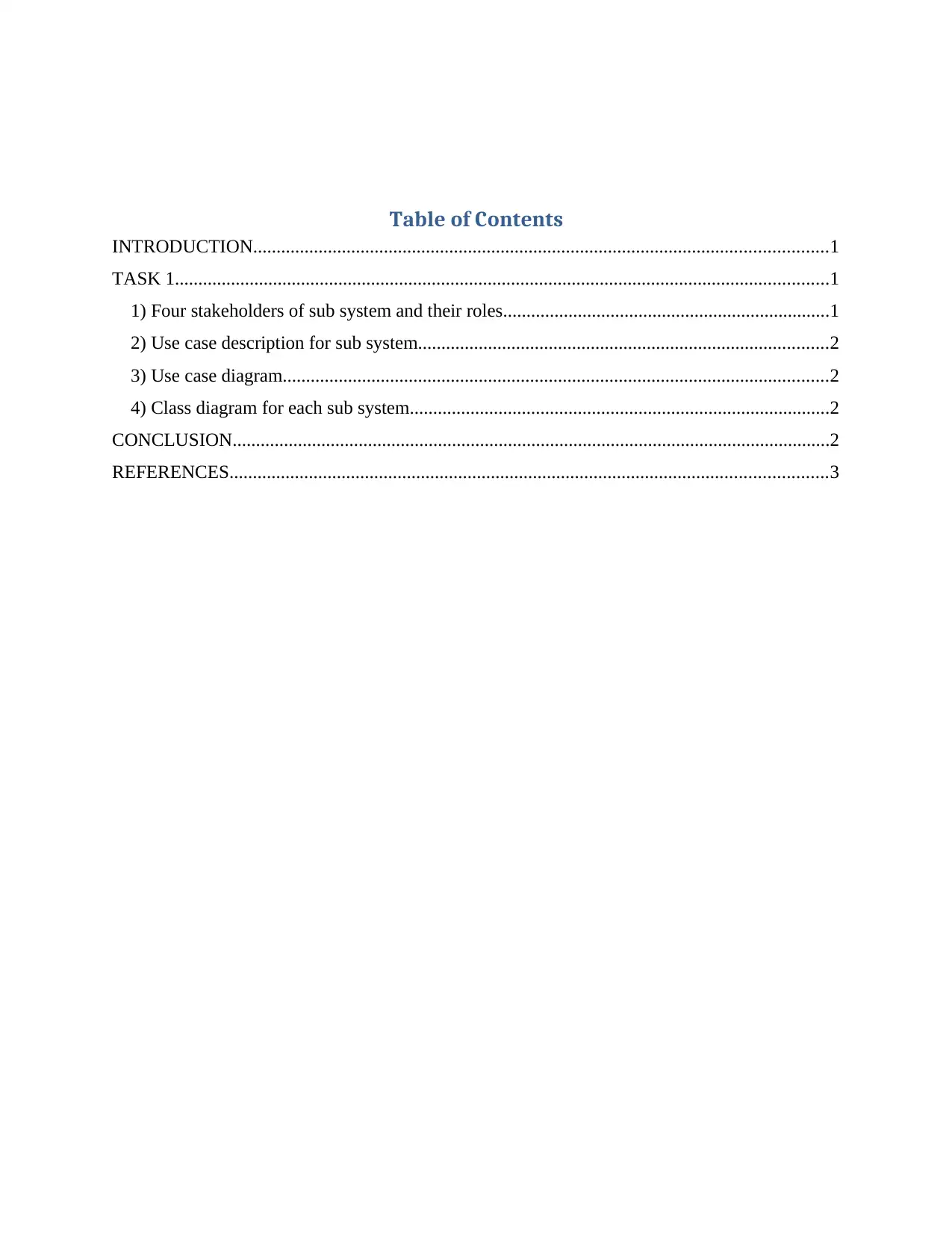
Table of Contents
INTRODUCTION...........................................................................................................................1
TASK 1............................................................................................................................................1
1) Four stakeholders of sub system and their roles......................................................................1
2) Use case description for sub system........................................................................................2
3) Use case diagram.....................................................................................................................2
4) Class diagram for each sub system..........................................................................................2
CONCLUSION................................................................................................................................2
REFERENCES................................................................................................................................3
INTRODUCTION...........................................................................................................................1
TASK 1............................................................................................................................................1
1) Four stakeholders of sub system and their roles......................................................................1
2) Use case description for sub system........................................................................................2
3) Use case diagram.....................................................................................................................2
4) Class diagram for each sub system..........................................................................................2
CONCLUSION................................................................................................................................2
REFERENCES................................................................................................................................3
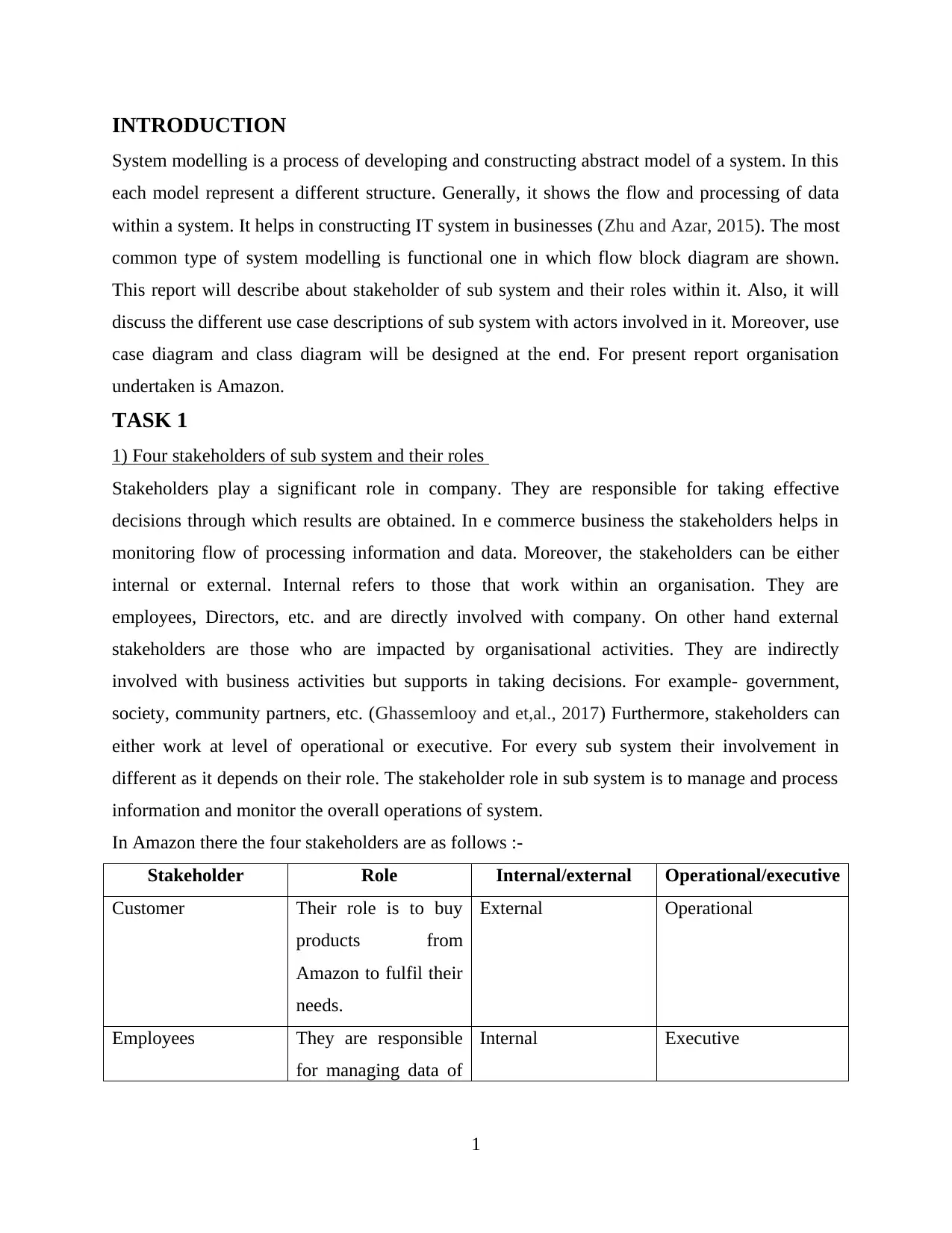
INTRODUCTION
System modelling is a process of developing and constructing abstract model of a system. In this
each model represent a different structure. Generally, it shows the flow and processing of data
within a system. It helps in constructing IT system in businesses (Zhu and Azar, 2015). The most
common type of system modelling is functional one in which flow block diagram are shown.
This report will describe about stakeholder of sub system and their roles within it. Also, it will
discuss the different use case descriptions of sub system with actors involved in it. Moreover, use
case diagram and class diagram will be designed at the end. For present report organisation
undertaken is Amazon.
TASK 1
1) Four stakeholders of sub system and their roles
Stakeholders play a significant role in company. They are responsible for taking effective
decisions through which results are obtained. In e commerce business the stakeholders helps in
monitoring flow of processing information and data. Moreover, the stakeholders can be either
internal or external. Internal refers to those that work within an organisation. They are
employees, Directors, etc. and are directly involved with company. On other hand external
stakeholders are those who are impacted by organisational activities. They are indirectly
involved with business activities but supports in taking decisions. For example- government,
society, community partners, etc. (Ghassemlooy and et,al., 2017) Furthermore, stakeholders can
either work at level of operational or executive. For every sub system their involvement in
different as it depends on their role. The stakeholder role in sub system is to manage and process
information and monitor the overall operations of system.
In Amazon there the four stakeholders are as follows :-
Stakeholder Role Internal/external Operational/executive
Customer Their role is to buy
products from
Amazon to fulfil their
needs.
External Operational
Employees They are responsible
for managing data of
Internal Executive
1
System modelling is a process of developing and constructing abstract model of a system. In this
each model represent a different structure. Generally, it shows the flow and processing of data
within a system. It helps in constructing IT system in businesses (Zhu and Azar, 2015). The most
common type of system modelling is functional one in which flow block diagram are shown.
This report will describe about stakeholder of sub system and their roles within it. Also, it will
discuss the different use case descriptions of sub system with actors involved in it. Moreover, use
case diagram and class diagram will be designed at the end. For present report organisation
undertaken is Amazon.
TASK 1
1) Four stakeholders of sub system and their roles
Stakeholders play a significant role in company. They are responsible for taking effective
decisions through which results are obtained. In e commerce business the stakeholders helps in
monitoring flow of processing information and data. Moreover, the stakeholders can be either
internal or external. Internal refers to those that work within an organisation. They are
employees, Directors, etc. and are directly involved with company. On other hand external
stakeholders are those who are impacted by organisational activities. They are indirectly
involved with business activities but supports in taking decisions. For example- government,
society, community partners, etc. (Ghassemlooy and et,al., 2017) Furthermore, stakeholders can
either work at level of operational or executive. For every sub system their involvement in
different as it depends on their role. The stakeholder role in sub system is to manage and process
information and monitor the overall operations of system.
In Amazon there the four stakeholders are as follows :-
Stakeholder Role Internal/external Operational/executive
Customer Their role is to buy
products from
Amazon to fulfil their
needs.
External Operational
Employees They are responsible
for managing data of
Internal Executive
1
⊘ This is a preview!⊘
Do you want full access?
Subscribe today to unlock all pages.

Trusted by 1+ million students worldwide
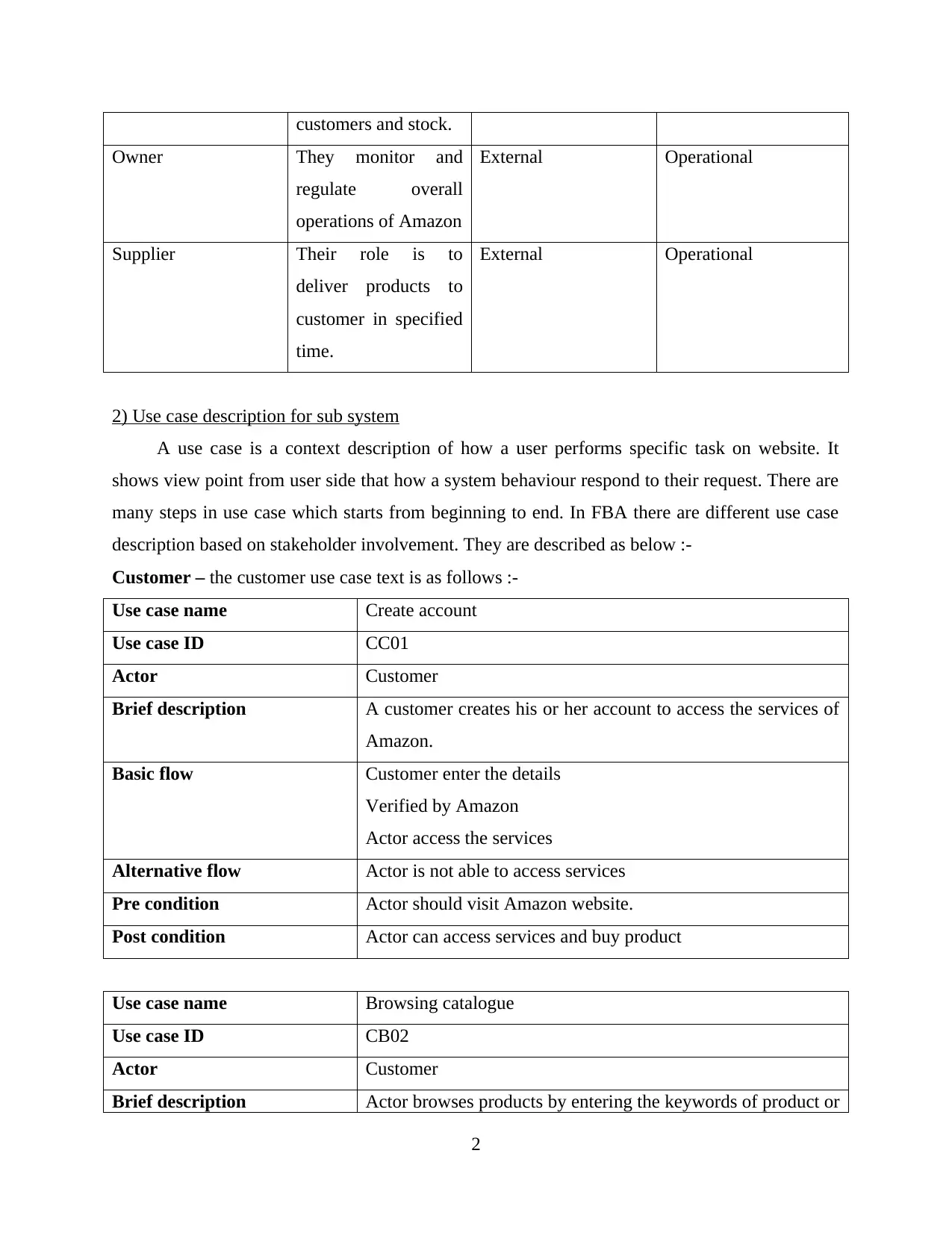
customers and stock.
Owner They monitor and
regulate overall
operations of Amazon
External Operational
Supplier Their role is to
deliver products to
customer in specified
time.
External Operational
2) Use case description for sub system
A use case is a context description of how a user performs specific task on website. It
shows view point from user side that how a system behaviour respond to their request. There are
many steps in use case which starts from beginning to end. In FBA there are different use case
description based on stakeholder involvement. They are described as below :-
Customer – the customer use case text is as follows :-
Use case name Create account
Use case ID CC01
Actor Customer
Brief description A customer creates his or her account to access the services of
Amazon.
Basic flow Customer enter the details
Verified by Amazon
Actor access the services
Alternative flow Actor is not able to access services
Pre condition Actor should visit Amazon website.
Post condition Actor can access services and buy product
Use case name Browsing catalogue
Use case ID CB02
Actor Customer
Brief description Actor browses products by entering the keywords of product or
2
Owner They monitor and
regulate overall
operations of Amazon
External Operational
Supplier Their role is to
deliver products to
customer in specified
time.
External Operational
2) Use case description for sub system
A use case is a context description of how a user performs specific task on website. It
shows view point from user side that how a system behaviour respond to their request. There are
many steps in use case which starts from beginning to end. In FBA there are different use case
description based on stakeholder involvement. They are described as below :-
Customer – the customer use case text is as follows :-
Use case name Create account
Use case ID CC01
Actor Customer
Brief description A customer creates his or her account to access the services of
Amazon.
Basic flow Customer enter the details
Verified by Amazon
Actor access the services
Alternative flow Actor is not able to access services
Pre condition Actor should visit Amazon website.
Post condition Actor can access services and buy product
Use case name Browsing catalogue
Use case ID CB02
Actor Customer
Brief description Actor browses products by entering the keywords of product or
2
Paraphrase This Document
Need a fresh take? Get an instant paraphrase of this document with our AI Paraphraser
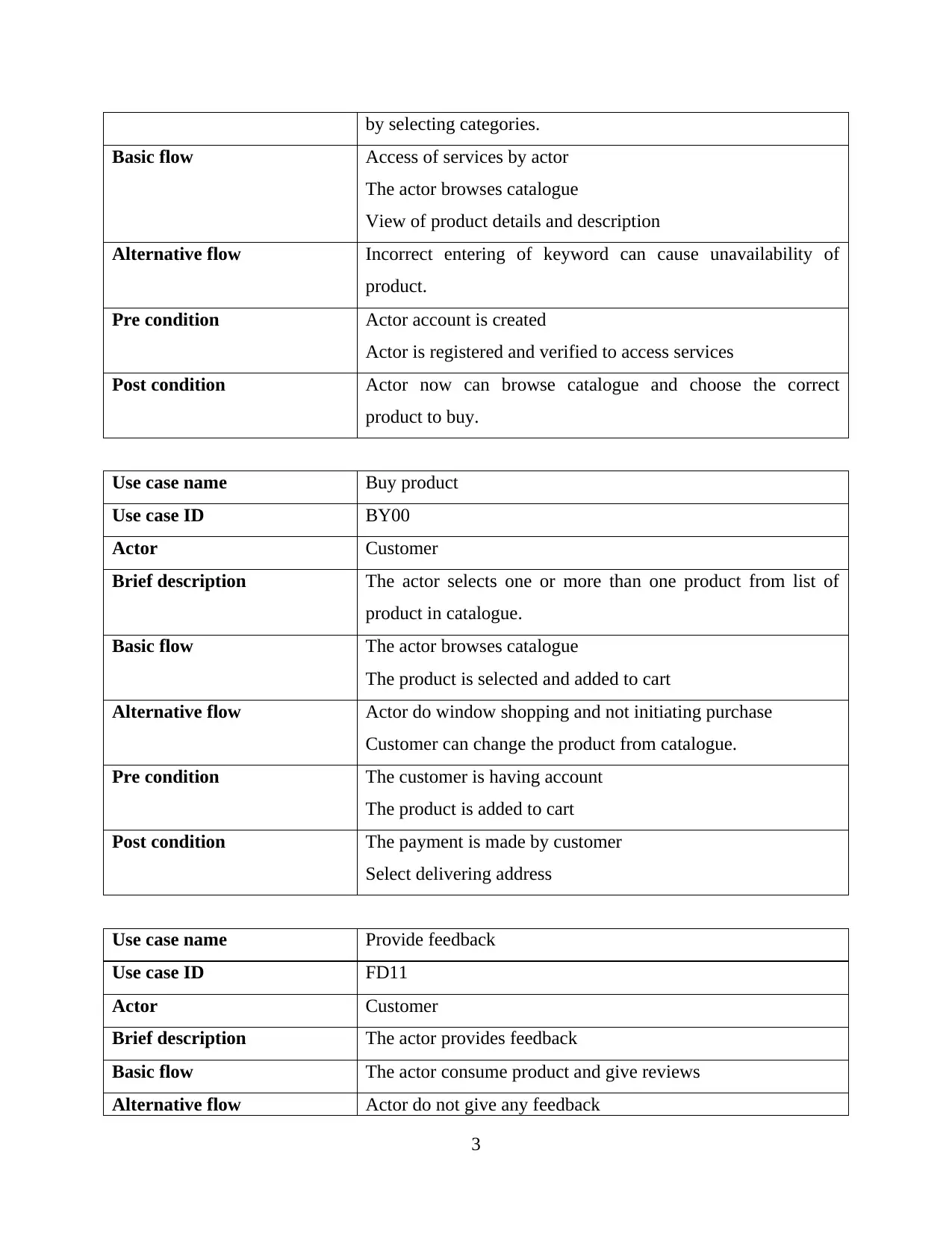
by selecting categories.
Basic flow Access of services by actor
The actor browses catalogue
View of product details and description
Alternative flow Incorrect entering of keyword can cause unavailability of
product.
Pre condition Actor account is created
Actor is registered and verified to access services
Post condition Actor now can browse catalogue and choose the correct
product to buy.
Use case name Buy product
Use case ID BY00
Actor Customer
Brief description The actor selects one or more than one product from list of
product in catalogue.
Basic flow The actor browses catalogue
The product is selected and added to cart
Alternative flow Actor do window shopping and not initiating purchase
Customer can change the product from catalogue.
Pre condition The customer is having account
The product is added to cart
Post condition The payment is made by customer
Select delivering address
Use case name Provide feedback
Use case ID FD11
Actor Customer
Brief description The actor provides feedback
Basic flow The actor consume product and give reviews
Alternative flow Actor do not give any feedback
3
Basic flow Access of services by actor
The actor browses catalogue
View of product details and description
Alternative flow Incorrect entering of keyword can cause unavailability of
product.
Pre condition Actor account is created
Actor is registered and verified to access services
Post condition Actor now can browse catalogue and choose the correct
product to buy.
Use case name Buy product
Use case ID BY00
Actor Customer
Brief description The actor selects one or more than one product from list of
product in catalogue.
Basic flow The actor browses catalogue
The product is selected and added to cart
Alternative flow Actor do window shopping and not initiating purchase
Customer can change the product from catalogue.
Pre condition The customer is having account
The product is added to cart
Post condition The payment is made by customer
Select delivering address
Use case name Provide feedback
Use case ID FD11
Actor Customer
Brief description The actor provides feedback
Basic flow The actor consume product and give reviews
Alternative flow Actor do not give any feedback
3
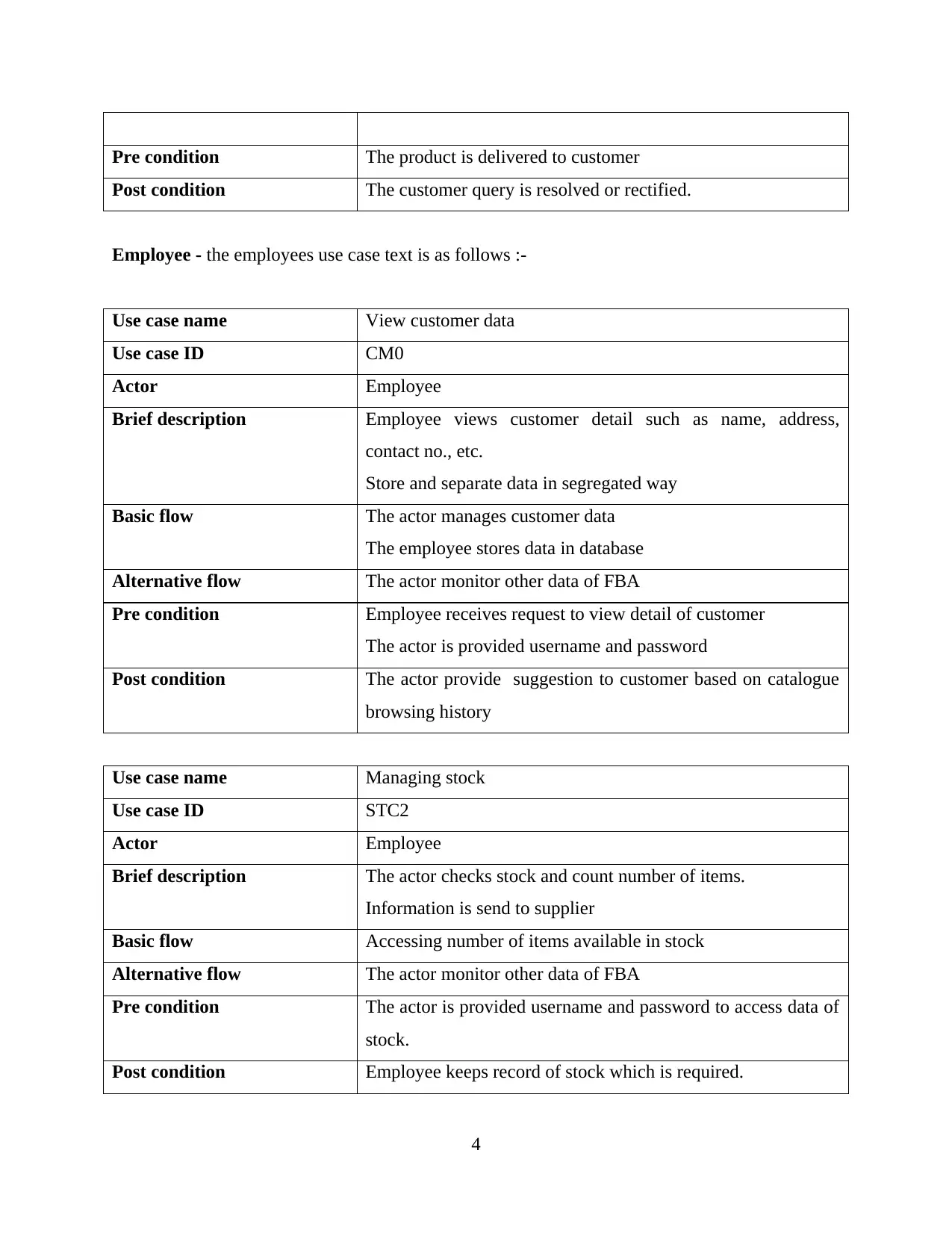
Pre condition The product is delivered to customer
Post condition The customer query is resolved or rectified.
Employee - the employees use case text is as follows :-
Use case name View customer data
Use case ID CM0
Actor Employee
Brief description Employee views customer detail such as name, address,
contact no., etc.
Store and separate data in segregated way
Basic flow The actor manages customer data
The employee stores data in database
Alternative flow The actor monitor other data of FBA
Pre condition Employee receives request to view detail of customer
The actor is provided username and password
Post condition The actor provide suggestion to customer based on catalogue
browsing history
Use case name Managing stock
Use case ID STC2
Actor Employee
Brief description The actor checks stock and count number of items.
Information is send to supplier
Basic flow Accessing number of items available in stock
Alternative flow The actor monitor other data of FBA
Pre condition The actor is provided username and password to access data of
stock.
Post condition Employee keeps record of stock which is required.
4
Post condition The customer query is resolved or rectified.
Employee - the employees use case text is as follows :-
Use case name View customer data
Use case ID CM0
Actor Employee
Brief description Employee views customer detail such as name, address,
contact no., etc.
Store and separate data in segregated way
Basic flow The actor manages customer data
The employee stores data in database
Alternative flow The actor monitor other data of FBA
Pre condition Employee receives request to view detail of customer
The actor is provided username and password
Post condition The actor provide suggestion to customer based on catalogue
browsing history
Use case name Managing stock
Use case ID STC2
Actor Employee
Brief description The actor checks stock and count number of items.
Information is send to supplier
Basic flow Accessing number of items available in stock
Alternative flow The actor monitor other data of FBA
Pre condition The actor is provided username and password to access data of
stock.
Post condition Employee keeps record of stock which is required.
4
⊘ This is a preview!⊘
Do you want full access?
Subscribe today to unlock all pages.

Trusted by 1+ million students worldwide
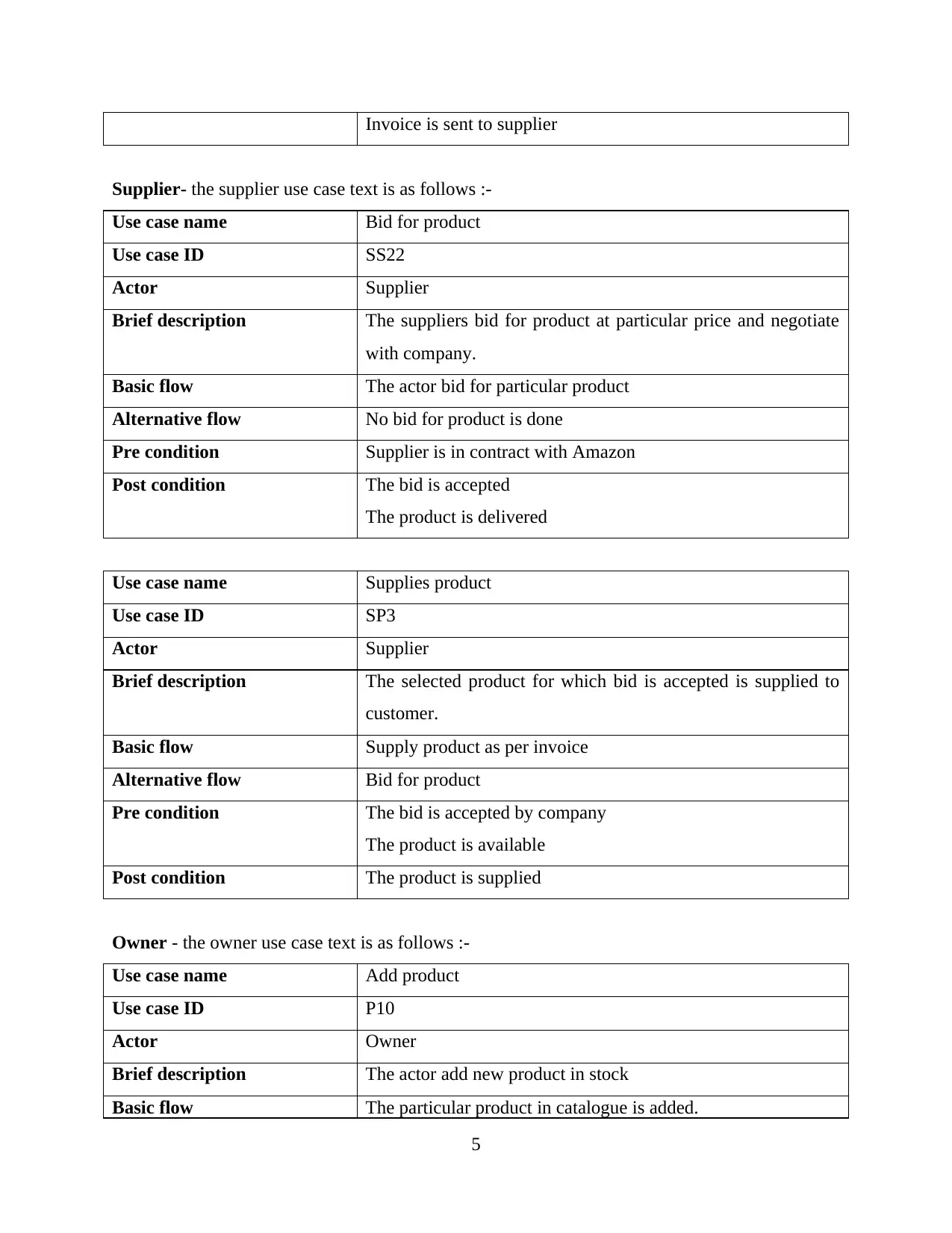
Invoice is sent to supplier
Supplier- the supplier use case text is as follows :-
Use case name Bid for product
Use case ID SS22
Actor Supplier
Brief description The suppliers bid for product at particular price and negotiate
with company.
Basic flow The actor bid for particular product
Alternative flow No bid for product is done
Pre condition Supplier is in contract with Amazon
Post condition The bid is accepted
The product is delivered
Use case name Supplies product
Use case ID SP3
Actor Supplier
Brief description The selected product for which bid is accepted is supplied to
customer.
Basic flow Supply product as per invoice
Alternative flow Bid for product
Pre condition The bid is accepted by company
The product is available
Post condition The product is supplied
Owner - the owner use case text is as follows :-
Use case name Add product
Use case ID P10
Actor Owner
Brief description The actor add new product in stock
Basic flow The particular product in catalogue is added.
5
Supplier- the supplier use case text is as follows :-
Use case name Bid for product
Use case ID SS22
Actor Supplier
Brief description The suppliers bid for product at particular price and negotiate
with company.
Basic flow The actor bid for particular product
Alternative flow No bid for product is done
Pre condition Supplier is in contract with Amazon
Post condition The bid is accepted
The product is delivered
Use case name Supplies product
Use case ID SP3
Actor Supplier
Brief description The selected product for which bid is accepted is supplied to
customer.
Basic flow Supply product as per invoice
Alternative flow Bid for product
Pre condition The bid is accepted by company
The product is available
Post condition The product is supplied
Owner - the owner use case text is as follows :-
Use case name Add product
Use case ID P10
Actor Owner
Brief description The actor add new product in stock
Basic flow The particular product in catalogue is added.
5
Paraphrase This Document
Need a fresh take? Get an instant paraphrase of this document with our AI Paraphraser
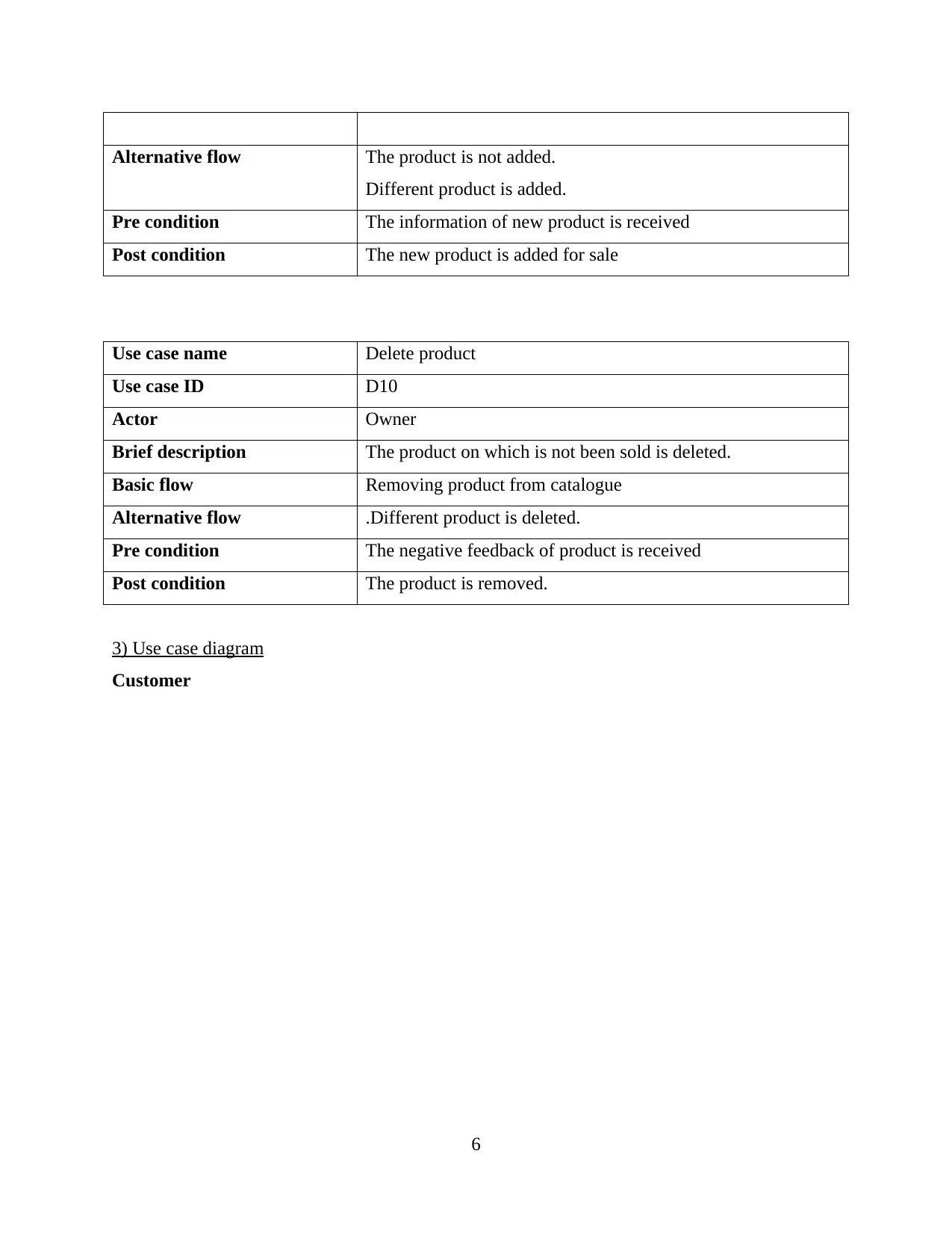
Alternative flow The product is not added.
Different product is added.
Pre condition The information of new product is received
Post condition The new product is added for sale
Use case name Delete product
Use case ID D10
Actor Owner
Brief description The product on which is not been sold is deleted.
Basic flow Removing product from catalogue
Alternative flow .Different product is deleted.
Pre condition The negative feedback of product is received
Post condition The product is removed.
3) Use case diagram
Customer
6
Different product is added.
Pre condition The information of new product is received
Post condition The new product is added for sale
Use case name Delete product
Use case ID D10
Actor Owner
Brief description The product on which is not been sold is deleted.
Basic flow Removing product from catalogue
Alternative flow .Different product is deleted.
Pre condition The negative feedback of product is received
Post condition The product is removed.
3) Use case diagram
Customer
6
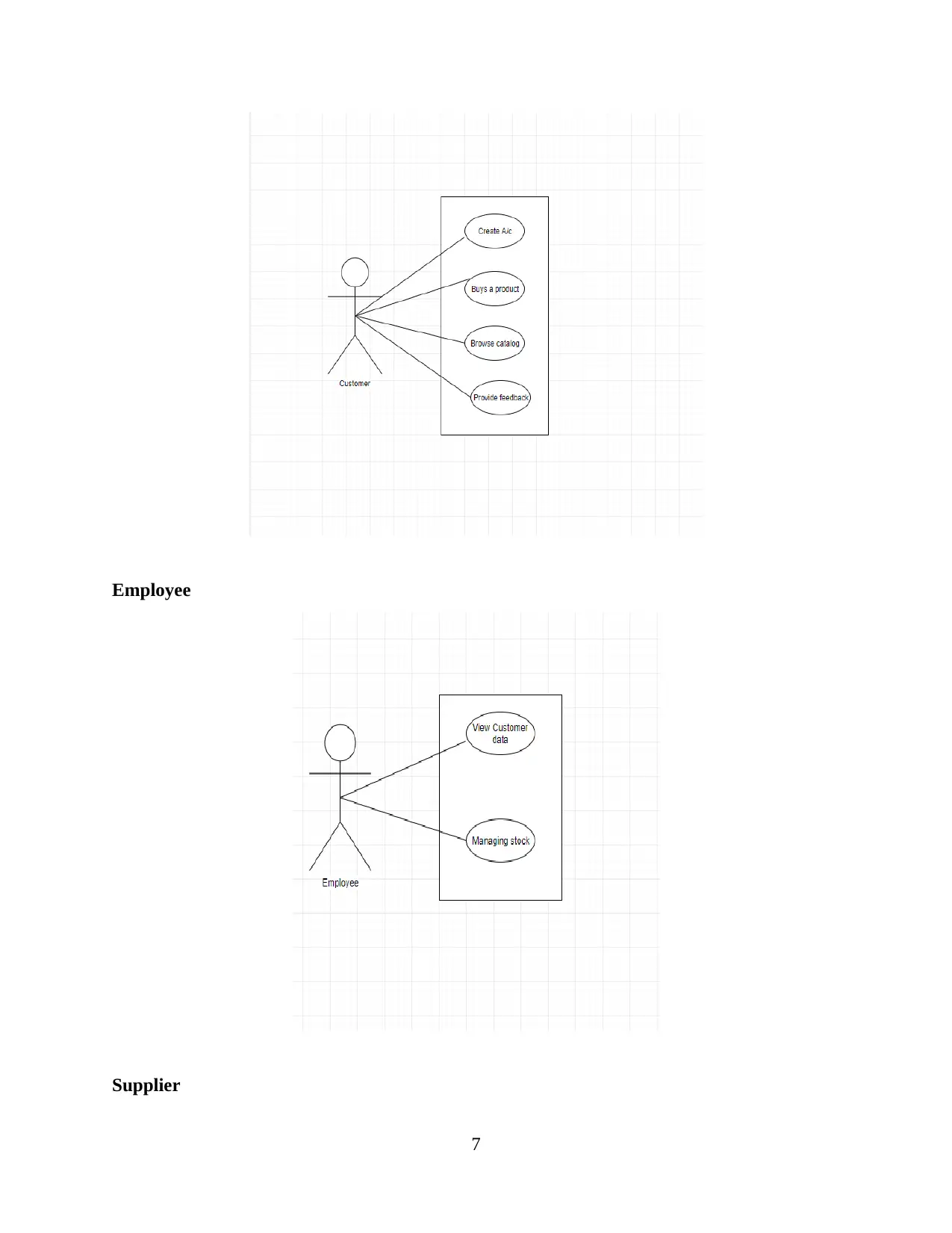
Employee
Supplier
7
Supplier
7
⊘ This is a preview!⊘
Do you want full access?
Subscribe today to unlock all pages.

Trusted by 1+ million students worldwide
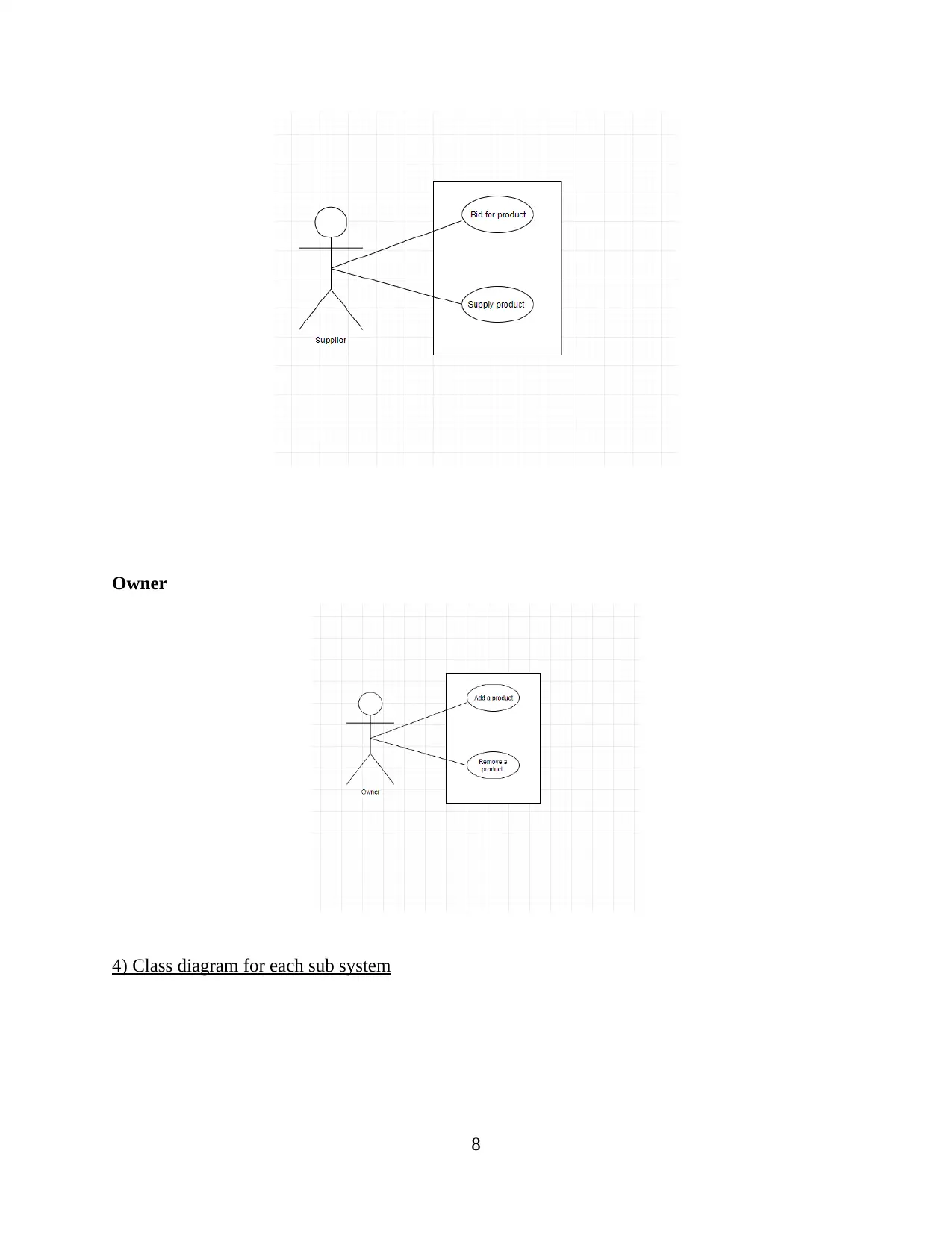
Owner
4) Class diagram for each sub system
8
4) Class diagram for each sub system
8
Paraphrase This Document
Need a fresh take? Get an instant paraphrase of this document with our AI Paraphraser
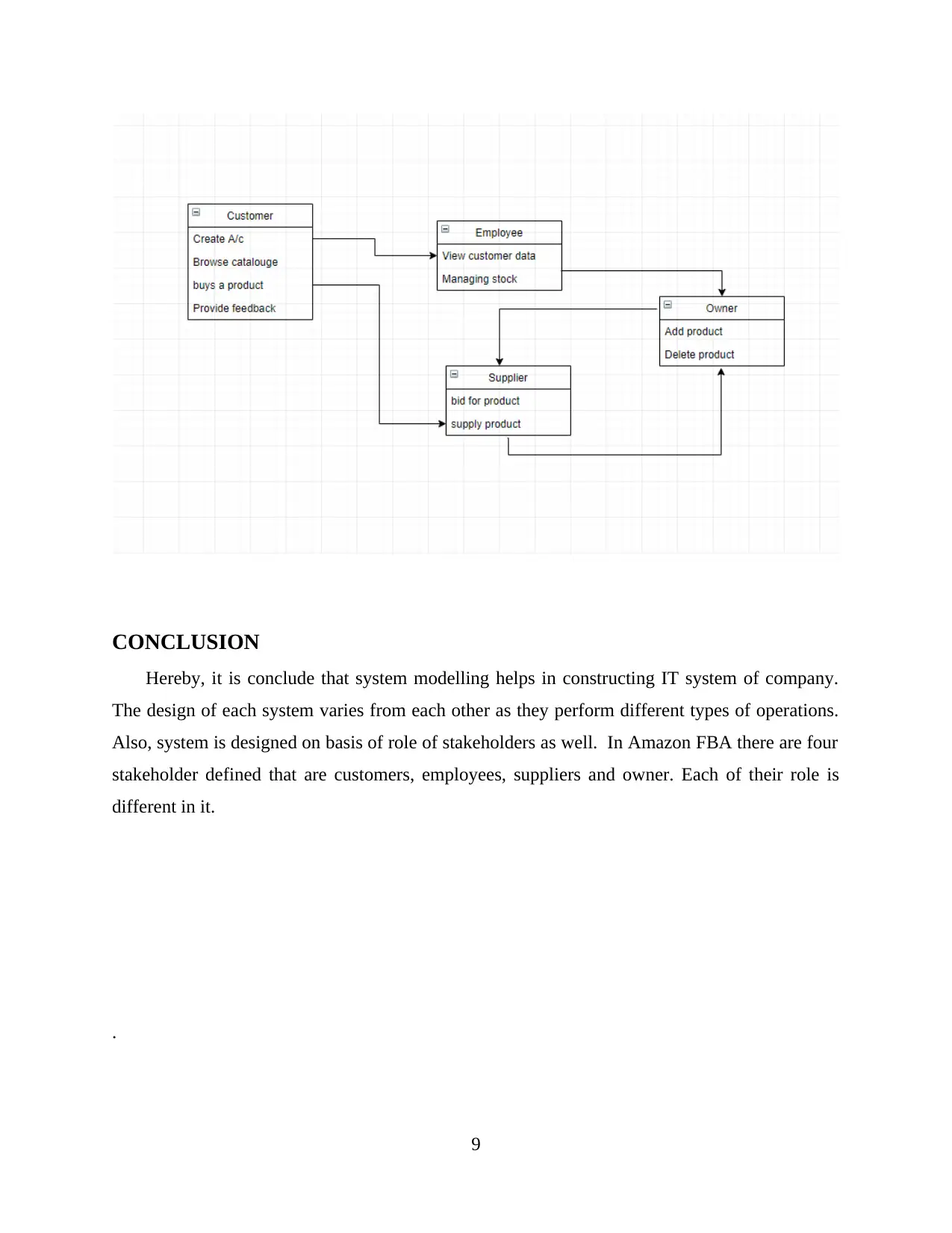
CONCLUSION
Hereby, it is conclude that system modelling helps in constructing IT system of company.
The design of each system varies from each other as they perform different types of operations.
Also, system is designed on basis of role of stakeholders as well. In Amazon FBA there are four
stakeholder defined that are customers, employees, suppliers and owner. Each of their role is
different in it.
.
9
Hereby, it is conclude that system modelling helps in constructing IT system of company.
The design of each system varies from each other as they perform different types of operations.
Also, system is designed on basis of role of stakeholders as well. In Amazon FBA there are four
stakeholder defined that are customers, employees, suppliers and owner. Each of their role is
different in it.
.
9
1 out of 11
Related Documents
Your All-in-One AI-Powered Toolkit for Academic Success.
+13062052269
info@desklib.com
Available 24*7 on WhatsApp / Email
![[object Object]](/_next/static/media/star-bottom.7253800d.svg)
Unlock your academic potential
Copyright © 2020–2025 A2Z Services. All Rights Reserved. Developed and managed by ZUCOL.





